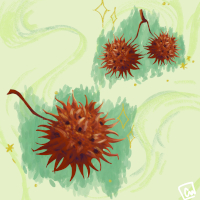Nonfiction by Lauren Annette Boulton
Well, I’ve returned it, the book that I’ve come to think of as your book, the book that I could not think of as the library’s book, or a collective “our” book. The book that resisted being called “my book” in the way I think about books I’ve consumed. I can’t remember the author. It isn’t the author’s book anymore.
With your picture, eight by ten and glossy, printed on heavy paper, you made it clear that Carnivorous Plants belonged to you.
String-haired man, flannel-coated man. What was it about Carnivorous Plants that made you so frantically move your hand above your open-flyed jean-crotch so quickly that it blurred in the photograph? Before I discovered your photo, I’d leafed through the first pages of Carnivorous Plants, found images of less threatening things—illustrations of people swallowed by pitcher plants, the staggered teeth of a Venus flytrap closing over a human body. The text explained that these things were myths. They were not real, just the product of legend.
#
As I’m sure you are at least subconsciously aware, there’s a historical legend of the vagina as carnivore, as man-eater. Vagina dentata, they call it. The vagina with teeth.
In Kawasaki, Japan, locals celebrate Kanamara Matsuri, or the Festival of the Steel Phallus. It’s a tradition that arises from an Aino folktale about a woman whose vagina was possessed by a toothed demon. After two of the woman’s grooms were castrated, she married a blacksmith. The blacksmith forged an iron phallus and pushed it inside his wife, shattering the demon’s teeth.
The vagina dentata is seemingly global. In India, the powerful and ferocious goddess Kali is often represented with vagina dentata. Mexican-American folklore describes chirrioneras, vaginal snakes that impregnate women and bite the men who try to have sex with them. Nightmarish.
Some theorize that the prevalence of this image across cultures suggests these tales are moral warnings against rape. The rooted fear is castration, removal of the thing that some men think makes them men. The fear of being like a woman. It arises when men fear women the most, fear powerlessness the most. After the Vietnam War, for example, American soldiers told stories about the danger inside Vietnamese women—razor blades, sand, broken Coke bottles, incurable gonorrhea, or grenades hidden in an invisible place.
Your book was hidden, too, among the shelves. I hadn’t been looking for it. On assignment, my grad school cohort went to the library in search of the pre-human, the language before people. I took you mistakenly, along with my books. Took you in the middle of a book about Carnivorous Plants in the middle of a stack of books about making dinosaurs and deciphering the language of bees and ontogeny recapitulating phylogeny. I chose the books shallowly, by title. I couldn’t resist Carnivorous Plants. Maybe that was your intention.
#
The depictions of vagina dentata vary in different contexts but often resemble Carnivorous Plants. It is easy to see how watching flowers like Hydnora africana (vaginal, but not technically carnivorous) “eat” dung beetles could inspire fear in the hearts of impressionable pubescents.
You were probably a college student when you picked up this book. Were you still scared? What did you want from Carnivorous Plants? Did you consider, as the writer does, your audience?
#
I read recently of a new device aimed at rape “defense”—a fourteen-cent female condom “lined with twenty-five razor-sharp teeth, which fasten onto an attacker’s penis if he attempts penetration.” So maybe vagina dentata is a legitimate concern. Maybe the warning folktales are materializing in the real world.
Like many so-called rape-defense devices, this device places the burden on the victim. It assumes that rape isn’t rape if his skin does not rub the inside of her, that rape is a purely physical act. That there is such a thing as retribution for rape. Naïve. Like you.
But perhaps you are not so young anymore, young man. Perhaps your photograph, a piece of you, an artifact, has long clung to the pages of dusty old Carnivorous Plants, timeless, Dorian-esque as you aged, as you grew wiser and more ashamed.
In fact, I doubt that your picture is new. The medium—glossy eight by ten on heavyweight paper—would be unusual for even the most hipster of my students. If you want to show a stranger a picture of your dick these days, don’t you just text it? Or Snapchat, or Chatroulette, or some other brand with chat in the name that involves very little talking?
You are more direct, but less identifiable. Probably. The stains could have been shelf wear, or they could have been something more insidious. I wondered, briefly, if the book had catalogued your DNA.
#
A night or two after I found your photo, I called my boyfriend and told him that sometimes I feel that the world is full of men trying to show me their dicks. If reading for a literary journal has taught me anything, it is that when there is a packet of poems from a male poet, it is likely to have at least one poem in which a penis is the star subject. From the fiction side of the room I hear this is a genre-bridging phenomenon. This obsession is tiring, annoying, and at times vaguely threatening. But it is mostly terribly innocuous writing.
Not so outside of the page, in the “real world,” where the threats are much more present. If you ask a woman how many penises she’s seen against her will, odds are that she will give you an alarming number. Or worse, she’ll have lost count. You’re nothing special, in that regard.
#
When I was an undergrad, a man was caught exposing himself in the library. Your place of aggression is also not an original one, I’m afraid. Another man would break into the dorm rooms of young women and jack off over their sleeping forms. It is so fucked up that my roommates and I had to put a system in place for what would happen if we awoke to a dude yanking it above our beds. I remember making jokes (Don’t scream! You do not want to leave your mouth open), but we were all eighteen and pretty freaked out. We were very careful to deadbolt the door every night.
This kind of threat seems to follow me, but I am starting to feel that it is an across-the-board phenomenon, that there are people like you in every town and city and rural unincorporated area. In the Ohio town that (you and?) I call home, earlier this year, a man exposed his penis in a Subway restaurant, demanding a blowjob and then a sandwich. It could have been you. It probably wasn’t.
Some people don’t believe people like you exist. They need personal stuff as evidence, and sometimes they still don’t want to think you are real. How many times, walking home from class, have I been threatened and evaluated and made a sexual object in broad daylight? How many times has a man yelled something rapey and violent from the safety of his pickup truck? How many times, while I’m dancing, has a man forced an erection against my body, stuck his hands down the front of my pants, uninvited? These are only the things that happen in public, out in the open, understand? These are only the people who are unafraid of public judgment.
And now you. In Carnivorous Plants.
#
You didn’t know it, but the person who discovered you knows the importance of a book, even one about carnivorous plants. The day I looked at your book was the day of my thesis defense. I was sitting in my office with my best friend, an extraordinary fiction writer named Liz Breazeale.
All morning I had been reexamining my manuscript, a collection of poems about human trafficking in the historical logging camps of my hometown. I wrote the book because I felt a thing, I felt many things for another human. I’m sure you’ve felt a thing for another person, or at the very least a carnivorous plant. If you have, you know that to feel so viscerally, to feel so hopeless in your feeling that you can’t help but find different ways to feel it, is unlike anything else. Over the course of the previous year, I’d spent countless hours researching, reading, daydreaming, writing, creating, workshopping, revising, tweaking, discussing, and agonizing over my work. At the beach on vacation, in the dentist’s chair, in the middle of giving a lecture on MLA format, I thought about my poems. I felt about my poems. They consumed me, with wide mouths and pointed teeth.
The more I think about it, the more I am certain that the now-anonymous author of Carnivorous Plants felt the same way. Something about Carnivorous Plants got ahold of them, swallowed them whole.
#
I know that idiots like you get off on reactions, so I’ll keep mine brief. I expressed my horror to Liz and buried the book in a stack of others that I needed to return. I defended my thesis, passed, had a celebratory glass of wine and pizza slice, went to a craft talk, drank a couple of ciders at my favorite dive bar. Cleaned my apartment, slept fine, graded, taught. I lived the regular boredom of everyday life. And after that, I saw your book again, on my desk in the pile.
I took it to the library and showed it to the student working at the desk, urging her to report it to her boss and inquiring if anything like this had happened before. She didn’t know. She looked about as thrilled as I felt, handling the stained thing by the edges, carrying it into the circulation librarian’s office.
#
I may never know, Carnivorous Plants man, exactly what secrets were held for me in Carnivorous Plants. Like so many men before you, you set out to make a place unsafe for me and my kind.
Just—damn you for making it a book. I thought I could be safe, inside a book, and I was wrong. Thanks to you, I have learned everything I know about carnivorous plants from a digital library database, from search engines. I’ll never know what it means to flip through the delights hidden by the curtains of pages, the deliciousness of devouring, page by page, what it means to be a plant that does not wish to sustain itself by sunlight alone.
Maybe the key to pre-human language was indeed in the spines of the sheep-trapping pineapple-cousin Puya chilensis or the curved red innards of a pitcher plant. Maybe it wasn’t. You should have given me the chance to find out whether I had nothing to learn from Carnivorous Plants.
#
When I was young, my grandmother had a Venus flytrap. She kept it in her dining room, next to the sliding glass door, among aloe and seedling tomatoes and peace lilies. One day, Grandma caught me with a pencil, poking the fine hairs and the center of the traps, watching them close. I suppose she could have told me some grownup lie—that the plant would chew up the eraser and my fingertips, that it would creep up the stairs at night and gobble me. Instead, she told me that if I touched it too much, the trap would stop working, that it wouldn’t be able to save the other plants from the pestilence of hungry insects. Okay, she didn’t say pestilence. I was nine. But still, this was a greater fear than some unbelievable story, the fear that I had stopped the innermost workings of something that fascinated me, something wonderful.
After I left the house, I imagined the carnivorous plant shrinking and dying away, the plants beside it holey with aphids. But she must have underestimated the will of the thing. The next time I came over, the traps were open again, red and hungry and fierce.



